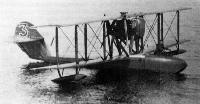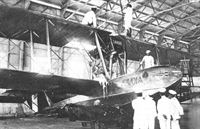
Описание
Страна: Италия
Год: 1919
В.Шавров История конструкций самолетов в СССР до 1938 г.
"Савойя" С-16 бис - трехместная летающая лодка-разведчик, двухстоечный биплан с двигателем "Фиат" A-12 бис в 300 л. с. Винт толкающий четырехлопастный. Конструкция - деревянная. Корпус лодки состоял из обычного каркаса и фанерной обшивки толщиной в основном 4 мм, оклеенной полотном. Ниже ватерлинии и по днищу фанера была обшита 4-мм досками шириной около 90 мм. По бортам эти доски были сосновые, по днищу - тополевые (под 45°) и по ним - тиковые. Между слоями их было проложено просмоленное полотно. Все было проклепано медными заклепками, как в поплавках Авро. Лодка была очень прочной. Был случай, когда самолет выдержал на плаву девять суток дрейфа, в том числе три дня шторма. Первоначально самолеты были закуплены в 1923 г., но затем было приобретено еще 50 самолетов, которые применялись до 1931 г. главным образом на Черном море. В 1926-1927 гг. на нескольких самолетах был установлен двигатель "Лоррэн-Дитрих" в 450 л. с. Модернизация называлась С-16 тер. Переделка производилась в OMOC. Скорость возросла, но дальность полета не увеличилась.
Самолет|| С- 16 бис/ С- 16 тер
Год выпуска||1923/1926
Назначение||Разведчик/Разведчик
Число мест||3/3
Двигатель , марка||/
Мощность, л.с.||300/450
Длина самолета, м||9,97/9,97
Размах крыла, м||15,5/15,5
Площадь крыла, м2||62/62
Масса пустого, кг||1750/1850
Масса топлива+ масла, кг||200+25/240+30
Масса полной нагрузки, кг||750/800
Полетная масса, кг||2500/2650
Удельная нагрузка на крыло, кг/м2||40,3/42,7
Удельная нагрузка на мощность, кг/лс||8/5,9
Весовая отдача, %||30/30
Скорость максимальная у земли, км/ч||165/180
Скорость максимальная на высоте, км/ч||120/140
Скорость посадочная, км/ч||85/90
Время набора высоты||
1000 м, мин||8/6
2000 м, мин||20/14
3000 м, мин||48/32
Потолок практический, м||3500/4000
Продолжительность полета, ч.||4/3,5
Дальность полета, км||550/550
Время виража, с||40/?
Разбег, м||500/400
Пробег, м||250/300
Описание:
- В.Шавров История конструкций самолетов в СССР до 1938 г.
- L.Andersson Soviet Aircraft and Aviation 1917-1941 (Putnam)
Фотографии
-
L.Andersson - Soviet Aircraft and Aviation 1917-1941 /Putnam/
A batch of Savoia S.16 flying-boats was ordered from Italy for re-equipment of the RKKVF naval reconnaissance otryady at Odessa and Sevastopol.
-
L.Andersson - Soviet Aircraft and Aviation 1917-1941 /Putnam/
The Savoia S.16s remained in service in the reconnaissance role until 1931 and were then retained as trainers.
-
R.Gentilli - Italian Aviation Units in the First World War. Vol.5 /Aeronaut/ (5)
The Maddalena, in the center, with Finnish airmen on a SIAI S.16 flying boat on Lake Maggiore.
-
R.Gentilli - Italian Aviation Units in the First World War. Vol.5 /Aeronaut/ (5)
Japanese Naval personnel examining the S.16 ter of De Pinedo. On its hull it shows the insignia of Point Cook naval air station, Australia.
-
R.Gentilli - Italian Aviation Units in the First World War. Vol.5 /Aeronaut/ (5)
De Pinedo checking the refuelling of his SIAI S.16 "Gennariello" somewhere in Australia.





